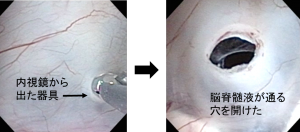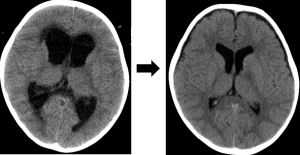Clinical Information
Endoscopic brain surgery
Brain diseases can also be treated by endoscopy
When you think of endoscopy, you may think of things like gastroscopy, but there are certain diseases that can be treated with endoscopy in the brain as well. At our hospital, many brain surgeries using endoscopes are performed by doctors who are certified by the Neuroendoscopy Society. Here are some typical brain endoscopic surgeries.

Endoscopes used in the brain
It is thinner than an endoscope, such as a gastroscope, to avoid damaging your precious brain.

Neuroendoscopic surgery
Do it while watching the monitor.
Diseases that can be treated by endoscopy: (1) Hydrocephalus
Hydrocephalus is a buildup of water (cerebrospinal fluid) in the brain, which can cause headaches, vomiting and, in severe cases, disorientation. It can be caused by a variety of congenital conditions that occur in childhood or by a brain tumor or brain hemorrhage. The most common treatment for hydrocephalus was to insert a thin tube into the ventricles of the brain, where cerebrospinal fluid is stored, and to pass the tube through the abdomen, or to perform a shunt operation. However, with the development of medicine, some causes of hydrocephalus can be treated by endoscopy.

(Left) Axial cross section of a healthy person’s brain
(Right) Brain of a patient with hydrocephalus: Water accumulation in the ventricles of the brain
For obstructive hydrocephalus, where the flow of water is blocked, endoscopic surgery can be used to create an alternative channel for water flow and cure the problem.
(1) Advance the endoscope to the ventricle where the water is stored.

(2) Remove the tool from the endoscope and make a hole in a safe place.

(3) The cerebrospinal fluid collected from the hole flowed and the hydrocephalus was cured.

Diseases that can be treated by endoscopy; (2) Brain tumor

An endoscope is inserted through the nose to remove the tumor in the back
Pituitary tumors and skull base tumors located in the back of the nose are the most effective for endoscopic surgery because they can be operated on through the nose (intranasal surgery) rather than through the cranium, which is a craniotomy. This is because the operation can be performed through the nose through an endoscope (nasal surgery) instead of craniotomy, which involves opening the skull bone. Therefore, the wound is not visible from the outside. In our hospital, we perform many nasal surgeries through the endoscope.

Tumor on the pituitary gland (pituitary adenoma): removed by endoscopy
